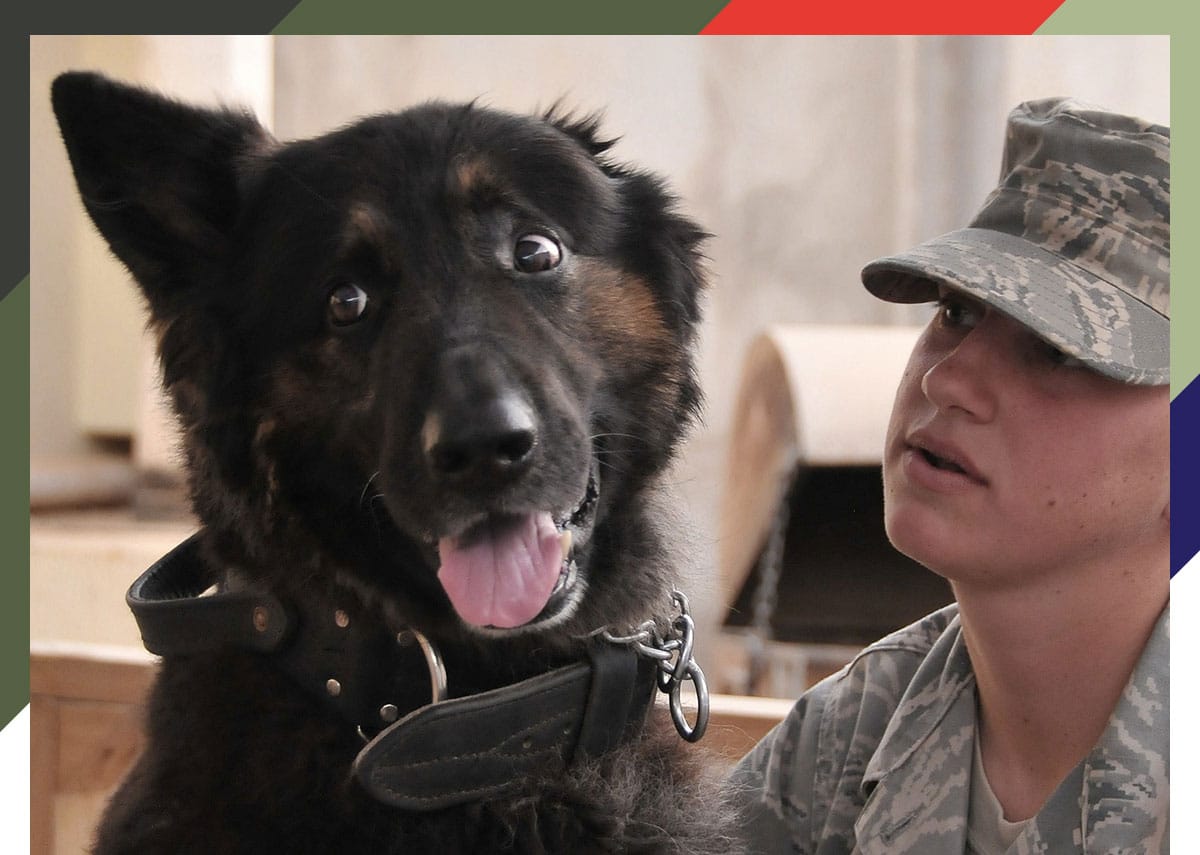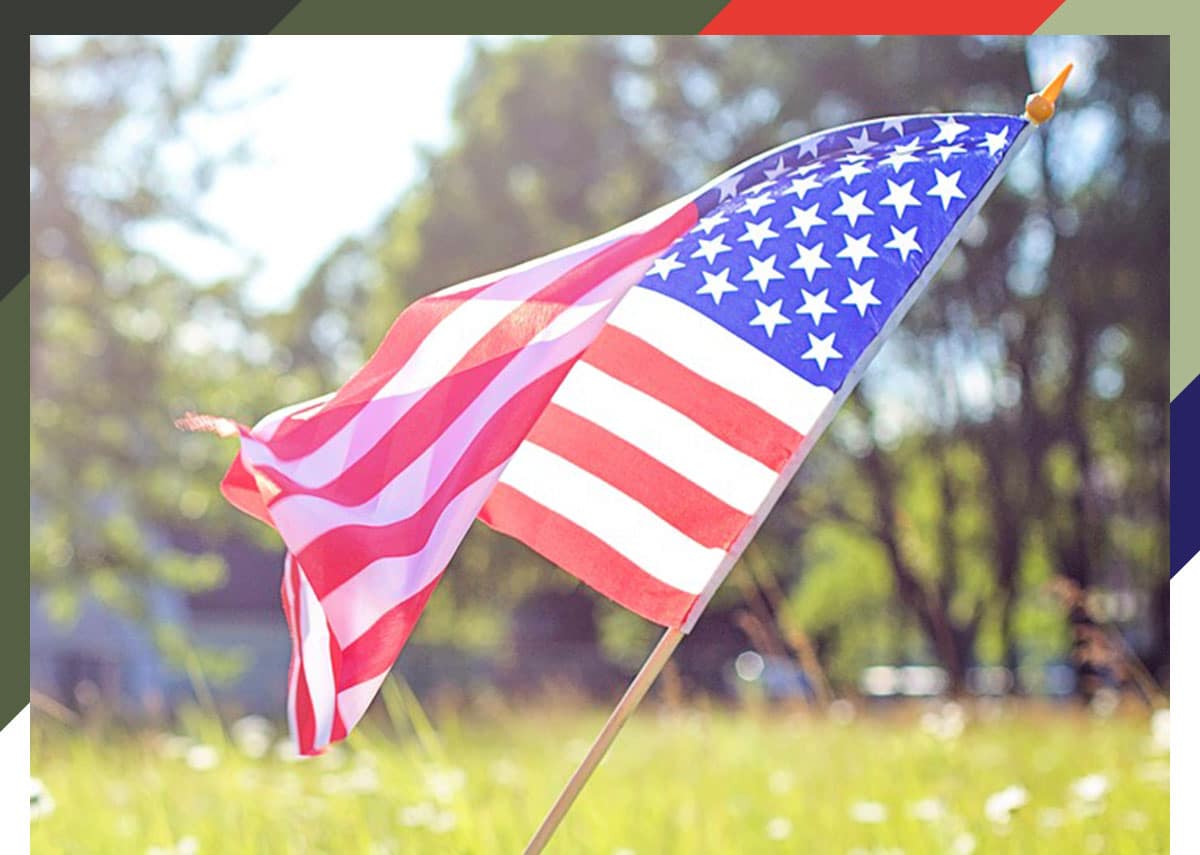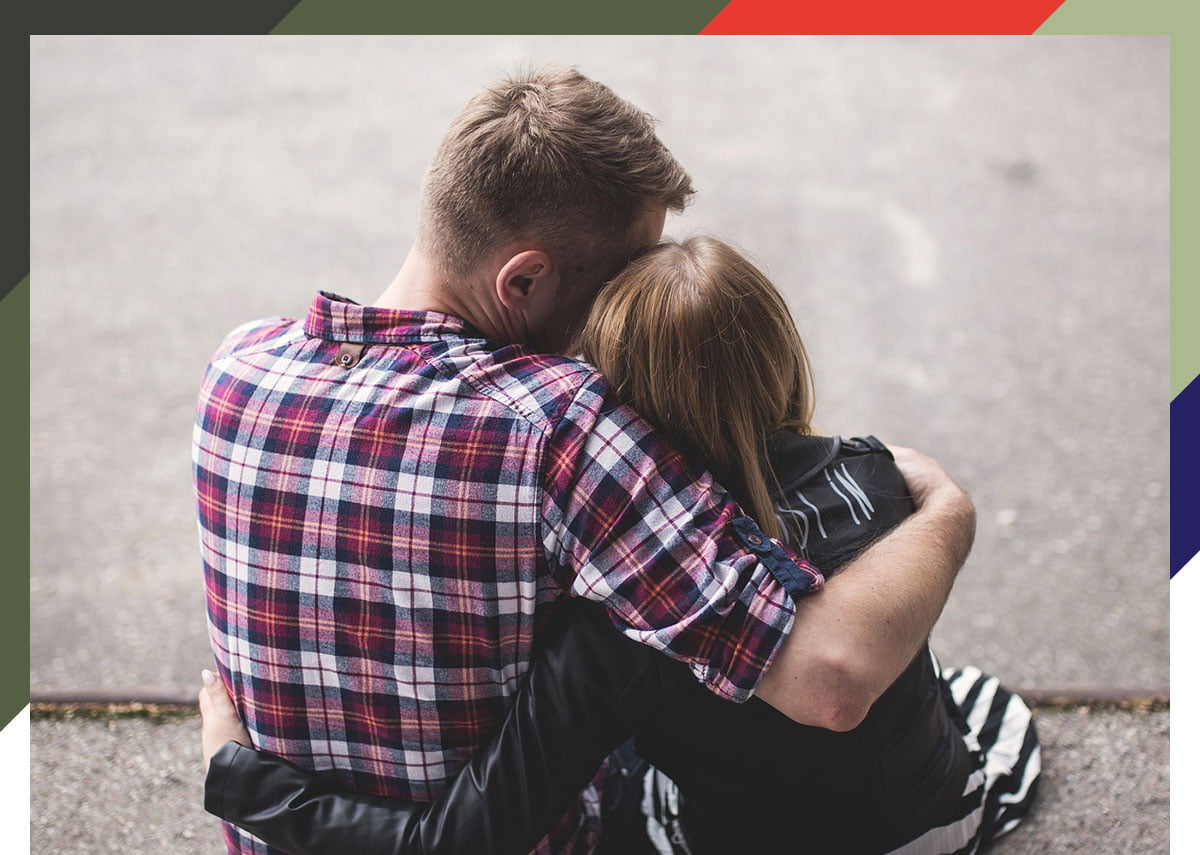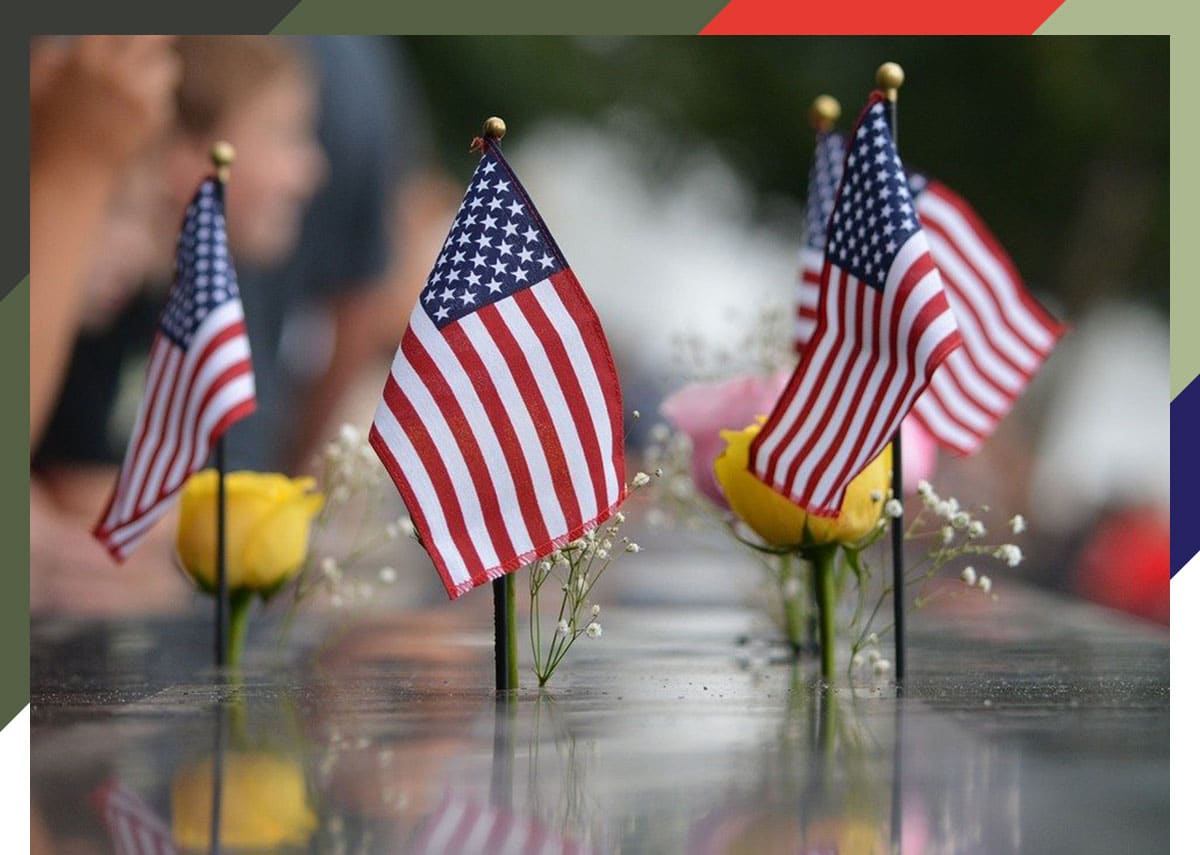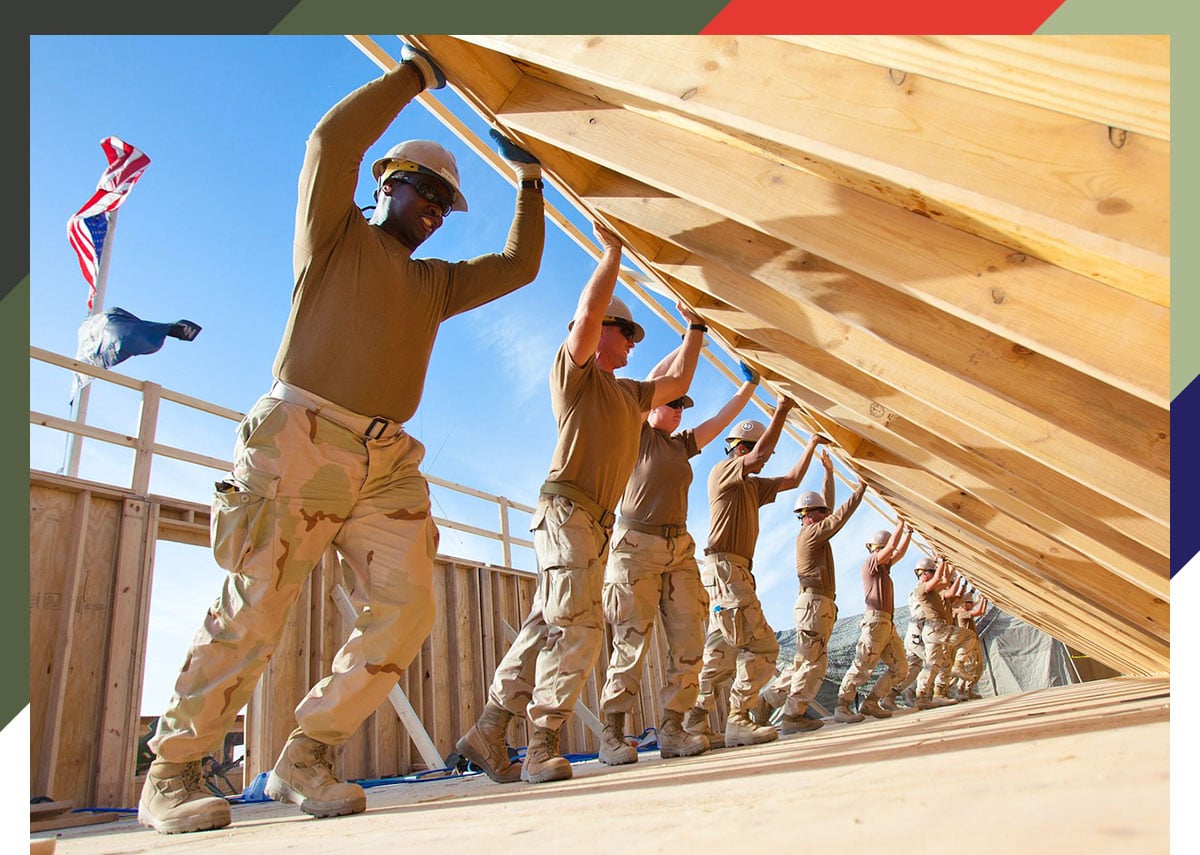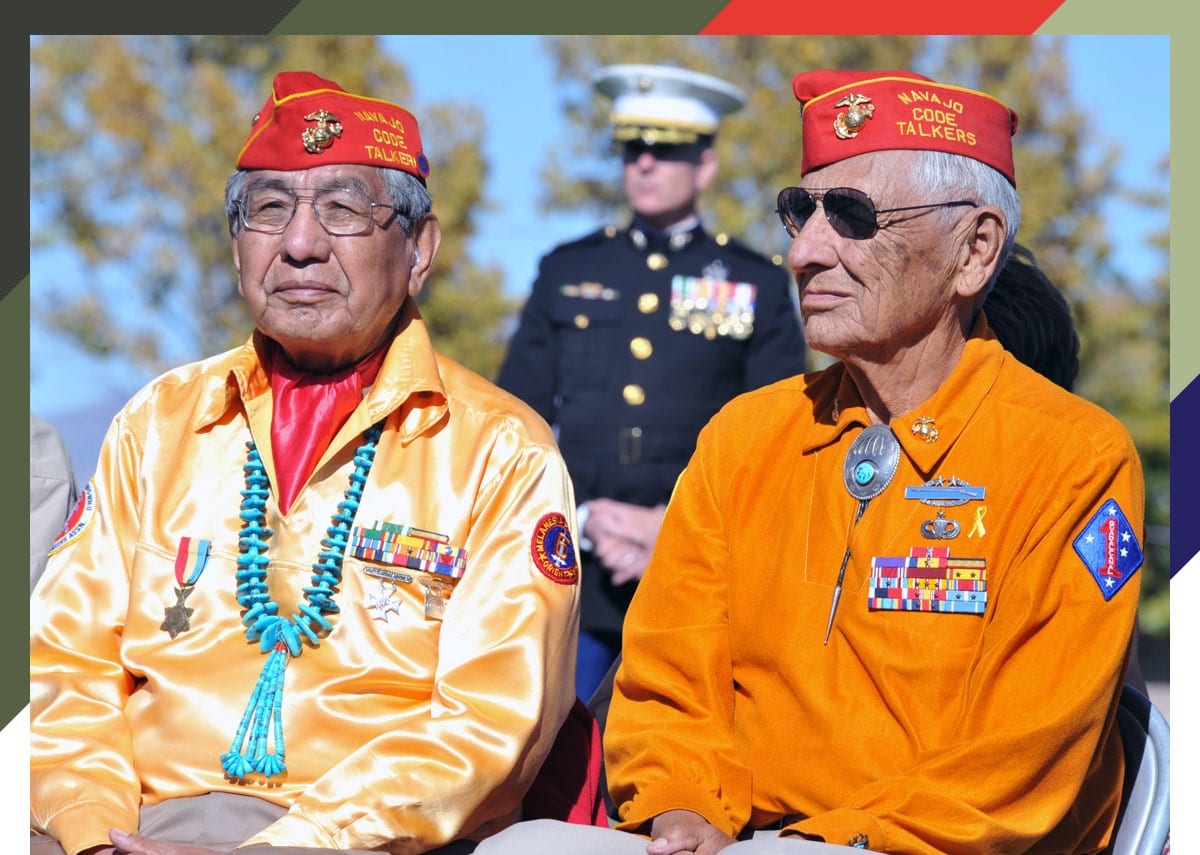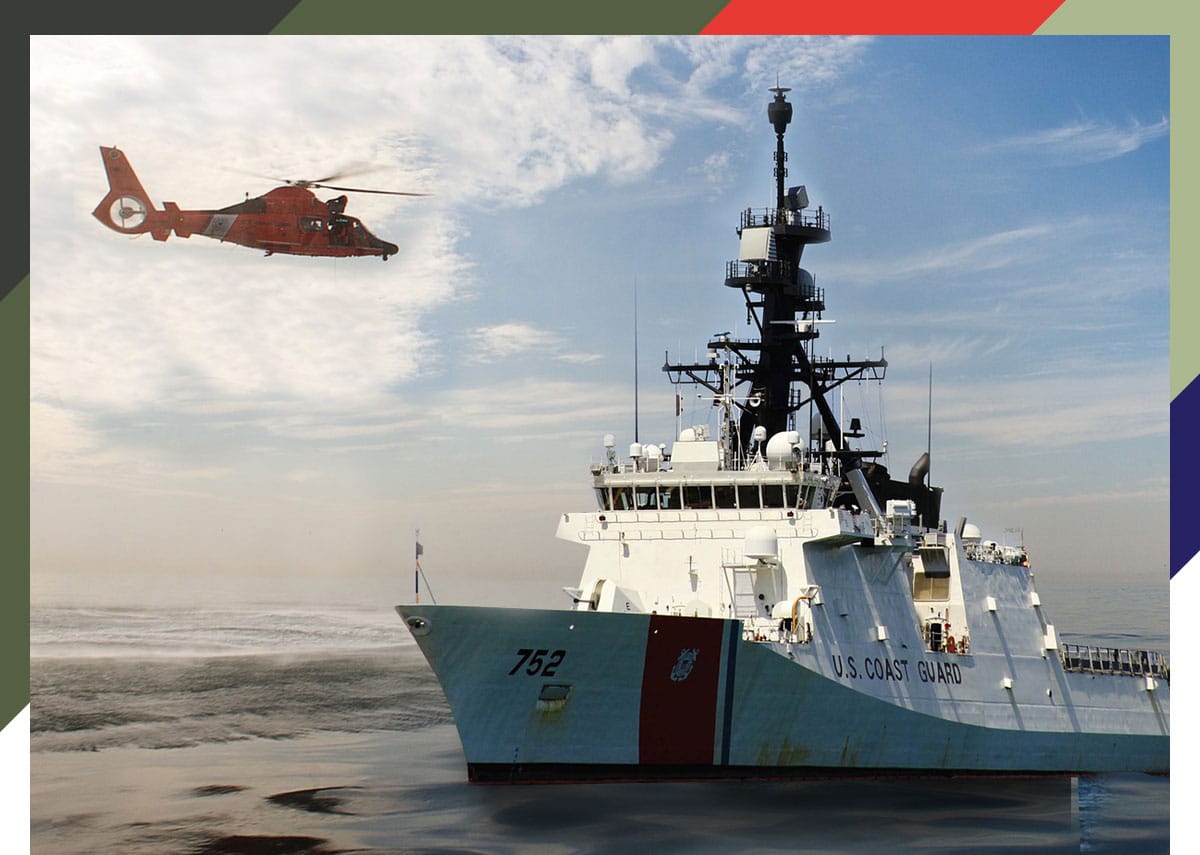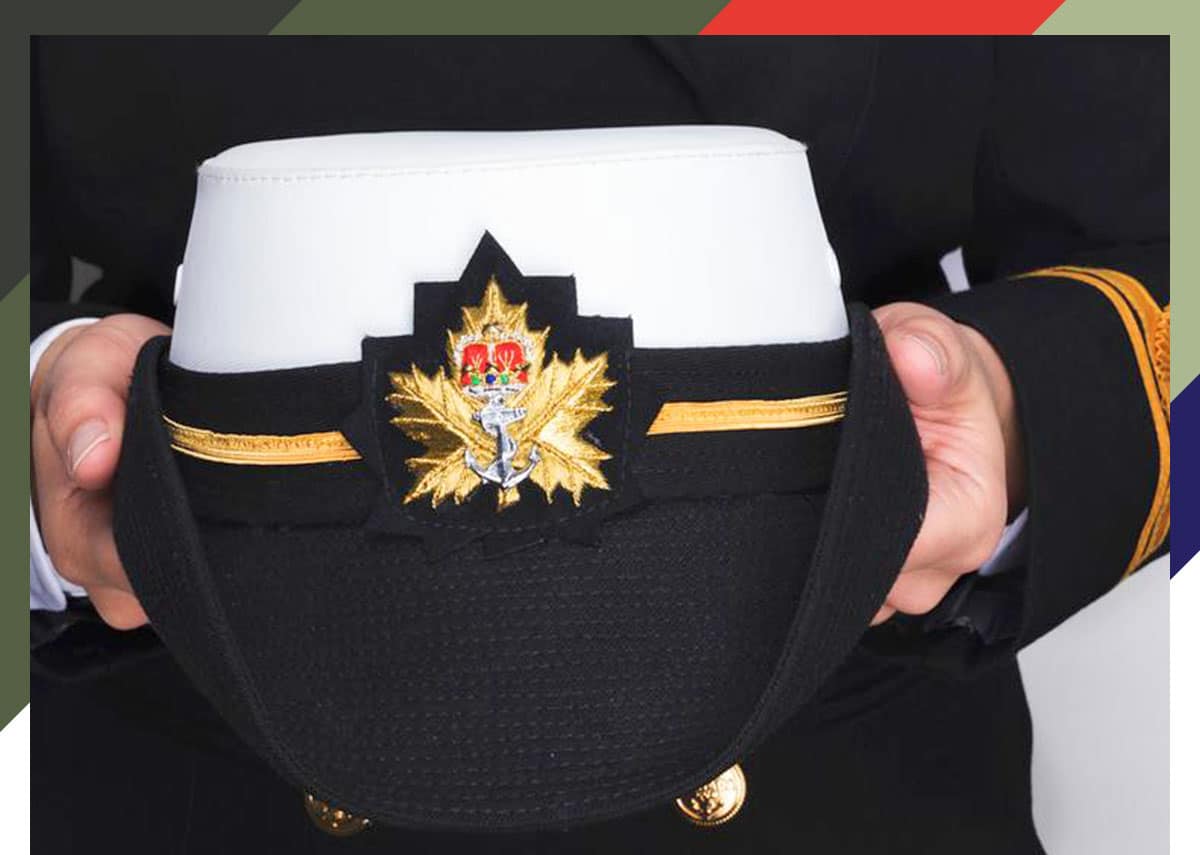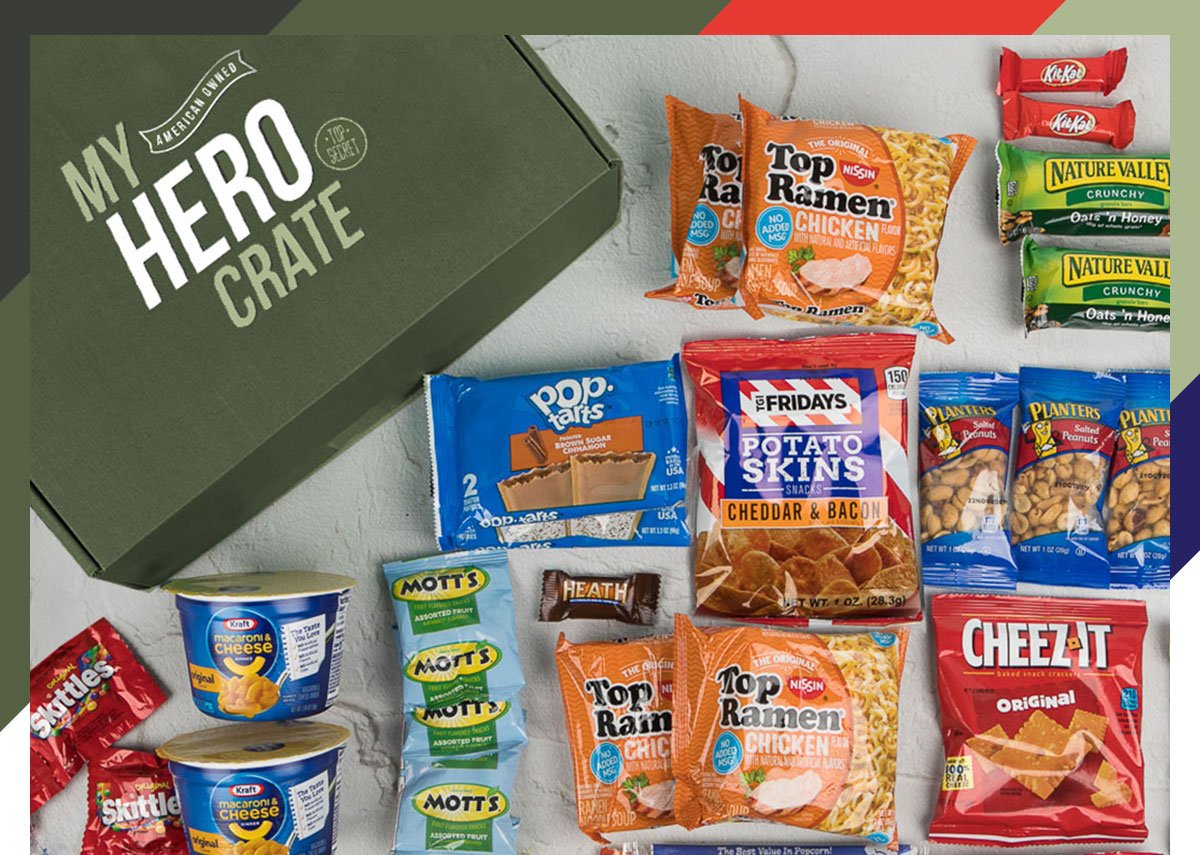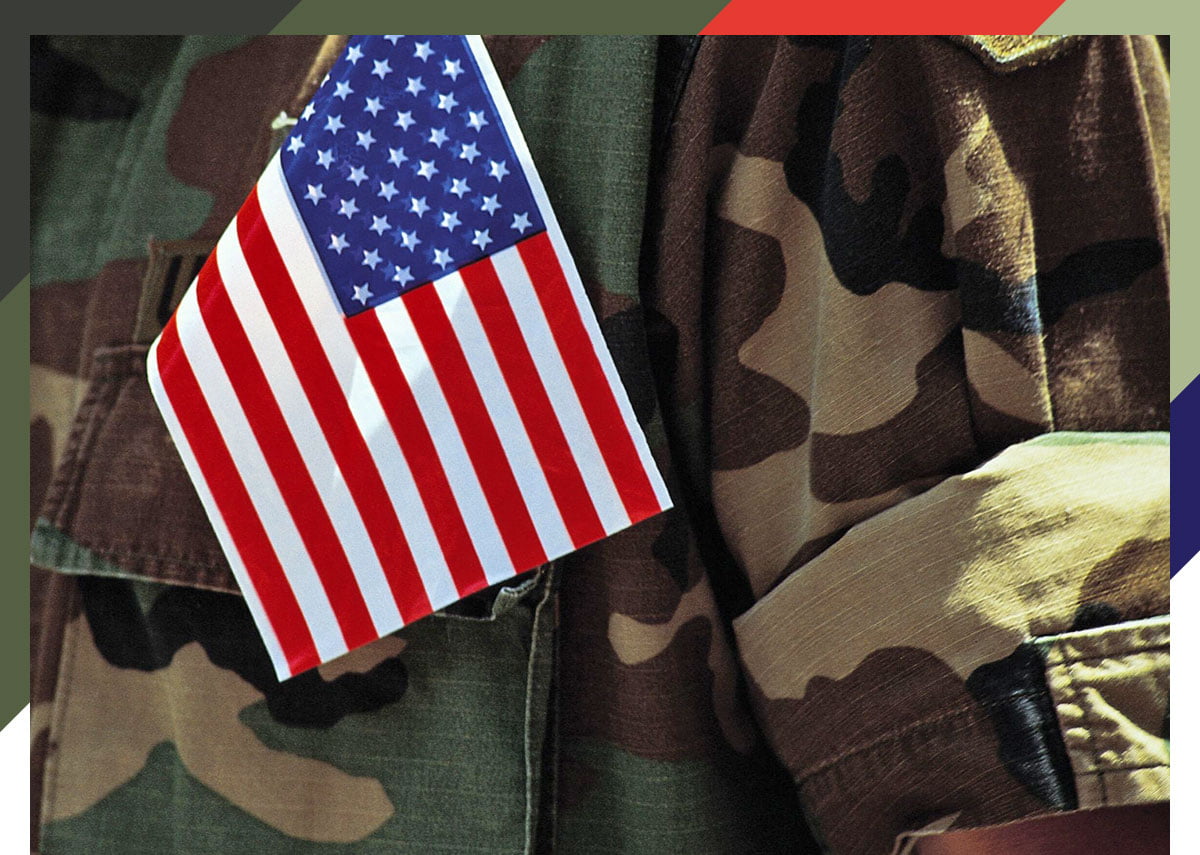Coming home after serving in the American armed forces is difficult. Just as your hero adjusted to life in the military, they have to re-adjust to living in the civilian world; this adjustment is sometimes much harder than the transition to military life because now, they have scars – physical and otherwise – from the battles they fought. At My Hero Crate, we know you want what is best for your hero when they return home. That’s why we do what we do: build and ship care packages for military members stationed all over the world, and donate some of our proceeds to a veteran non-profit organization. One thing that you can do, that perhaps you haven’t thought of, to aid in your hero’s transition, is to help them choose a pet that may provide them comfort and support. An emotional support animal provides comfort to help relieve a symptom of a person’s disability, such as anxiety, depression, or post-traumatic stress disorder. An emotional support animal is technically not a pet – but it isn’t a service animal either.
Caring for and living with a pet, such as a cat or dog, can help improve your hero’s life. Benefits include:
-Increasing well-being and improving mental health -Encouraging physical fitness (especially if the pet is a dog that requires lots of exercise!) -Strengthen social connections and improve relationships with others -Help overcome trauma -Prevent loneliness -Raise self-esteem and confidence -Give life purpose
If you’re unsure of whether an emotional support animal is right for your hero – or if perhaps a service dog would be better – it’s a good idea to talk to your loved one’s mental health team, who can provide their professional recommendations, give you documentation you need to house an emotional support or service animal in a rental home, and refer you to organizations that specialize in matching pets to veterans.
According to the American Society for the Prevention of Cruelty to Animals, 6.5 million dogs and cats enter animal shelters every year. An article in USA Today estimates that at least 20 percent of American soldiers return from abroad suffering with post-traumatic stress disorder. If a pet is right for each of these veterans, they can experience the feeling of saving an animal’s life and giving it a second chance.
If now isn’t the right time for a pet or support animal, help your veteran find time to relax and destress with our relaxation-inspiring gift sets, like our Men’s R&R Gift Box or our Women’s Relaxation Gift Box. Each military care package is full of items that encourage taking time for oneself.
Or, you can shop our full selection of military snack boxes with sweet and savory snacks from American suppliers, even if your soldier is still stationed overseas, nearing their discharge or retirement date. Shipping to APO, DPO, and FPO mailboxes is always free.
Honor Your Military Loved Ones Year-Round with R&R Gift Sets, Too
How Can an Animal Help?
Consider a Shelter Animal
Shelter animals are an especially good idea because it prevents 1.5 million of them annually from being euthanized. And, many shelter animals are well-suited to being obedient and loving pets. If you’re unsure of which pet to adopt, shelter workers can help you find one to best suit your lifestyle and needs. It may take patience to find the perfect pet, but it will be well worth it in the end.Encourage Relaxation
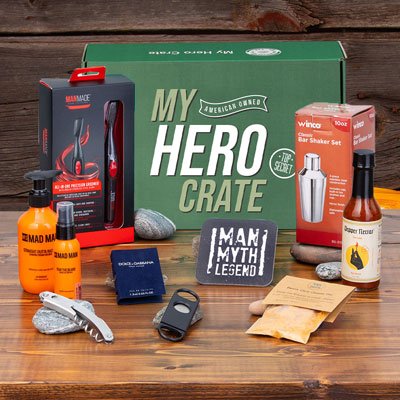
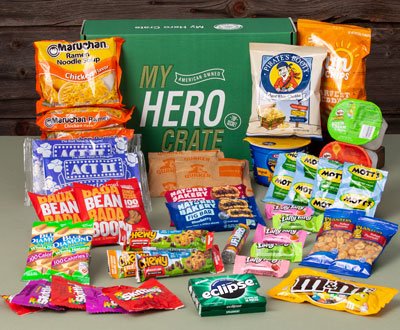
Category: Family
A Veterans Day Salute!
Thank Someone Who’s Served with a Care Package from My Hero Crate
On Veterans Day, you probably celebrate by enjoying a day off and casually thanking veterans you know for their service in whichever branch of the military they were in.
Once you live the American military life, though, you come to learn more about Veteran’s Day and appreciate it for how important it is. Here’s a quick history of the holiday, and how you can observe it.
The Date Is a Throwback to World War I
World War I ended when the Treaty of Versailles was signed on June 18, 1919. However, the fighting had already ended seven months prior with an Armistice between the Allies and Germany was called on the eleventh hour of the eleventh day of the eleventh month. For that reason, November 11, 1918, is known as the end of “the war to end all wars.”
In November 1919, President Woodrow Wilson proclaimed November 11 as the first commemoration of Armistice Day. He said, “To us in America, the reflections of Armistice Day will be filled with solemn pride in the heroism of those who died in this country’s service with gratitude for the victory, both because of the thing from which it has freed us and because of the opportunity it has given America to show her sympathy with peace and justice in the councils of the nations.” The original concept was a day to observe the Armistice and celebrate with parades, public meetings, and suspension of business.
Over the years, lawmakers passed resolutions to honor November 11, but it wasn’t until President Dwight D. Eisenhower issued the first Veterans Day Proclamation on October 8, 1954, that the day was officially cemented and special committees were formed and named to oversee the holiday. The very first Veterans Day was officially observed on October 25, 1971.
How to Celebrate Veterans Day
There are some easy ways to participate in acknowledging Veterans Day. Unfortunately, some of these ideas are not necessarily appropriate in our current pandemic. You can, however, hold onto these ideas so you are prepared to observe Veterans Day in the years to come.
-Attend a Veterans Day event in your area, such as a parade or special service.
-Donate to a non-profit organization that benefits your local veterans.
-Fly an American flag correctly, following U.S. Flag Code.
-Write a letter to troops stationed overseas, or a letter thanking veterans you personally know.
-Visit a VA hospital, where you can volunteer.
-Spend time with a veteran on this day, or any day of the year.
-Send a military care package to someone currently serving, or to someone who has retired from service, to thank them for their dedication to their country.
More Ideas?
Do you have great ideas for celebrating Veterans Day? Share them with your social networks to inspire other people to acknowledge the day. Reach out to your friends on various platforms, including NextDoor, Facebook, or Instagram, to remind them of the day’s importance.
How to Talk About Suicide
Ways You Can Help Your Hero in Need
My Hero Crate has made it our mission to improve the lives of veterans. Our method is to build military care packages for every branch of the armed forces and to ship them anywhere in the world, wherever your hero is living. We also support nonprofit, veteran-focused organizations because we put our money where our mouth is.
We are not experts in mental health or military suicides. We aren’t trained psychiatrists with an in-depth knowledge of how the brain works. But we do care a whole lot. And that’s why this month, National Suicide Prevention Month, we wanted to share with you some of the research we found about helping military veterans access the care they need, should they ever experience suicidal ideation. If this blog post helps even one veteran and the people that care about them get through a difficult time, then writing it will have been worth it.
A Long History of Veteran Suicide
It is more than unfortunate that United States military veteran suicide has been a phenomenon for decades; the very first suicide prevention center opened in 1958 because of the prolific number of veteran suicides. In the years since, the U.S. and Veterans Affairs have taken steps to reduce rates of suicide by establishing additional mental health resources and legislation. It is difficult, however, to fix the root cause of the problem.
According to a report published by the VA in 2016, an average of 20 veterans die from suicide each day. Further analysis of the VA study shows that the rate varies by age group. Sixty-nine percent of suicides involved veterans 50 and older, whereas 31 percent involved younger veterans. Ninety-seven percent of victims were male.
The cause? It’s not precise, but the majority of veterans who commit suicide reportedly struggled with post-traumatic stress disorder (PTSD), depression, and combat-related guilt. Transitioning back to civilian life can also be quite difficult, especially after years in the military.
Risk Factors for Veteran Suicide
The National Center for Veterans Studies at the University of Utah and the VA both say there are risk factors that increase the likelihood of military veterans experiencing suicidal ideation:
- -Feelings of depression or hopelessness
- -PTSD and/or a history of trauma
- -Access to firearms
- -Combat experience and combat-related guilt (although combat doesn’t always play a primary role in suicidal ideation); severe combat conditions
- -Lengthy or frequent deployments, or longer times at war
- -Location of deployment
- -Branch of military
- -Lower level of education
- -Divorce soon after the end of deployment
- -Sustaining life-altering injuries
- -Brain/head trauma
- -Witnessing traumatic events, such as their fellow soldiers being killed
- -Military structure and re-acclimating to civilian life
Suicide Warning Signs to Watch For
It’s difficult to predict when someone may be considering suicide, especially if they tend to hide their emotions. However, there is a set of common warning signs you can watch for as you interact with your hero at home, over the phone, or via mail.
- -They make statements about suicide, such as “I wish I were dead,” or, more specifically, “I’m going to kill myself.”
- -They withdraw from social contact, including their friends and other family members.
- -They seem preoccupied with death and dying, or violence.
- -Their personalities may change, or they may have severe mood swings.
- -They participate in risky behaviors, including using drugs, abusing alcohol, or driving recklessly.
- -They express that they feel trapped or hopeless.
- -They say goodbye to people as though they’ll never see them again.
- -They change their normal routine, including when and how often they eat or sleep.
- -They give away their belongings or “get their affairs in order.”
- -They have acquired means to commit suicide, including purchasing a gun, accessing pills, etc.
How to Start the Conversation with Your Hero
Don’t worry that if you ask your hero about suicidal thoughts or feelings, you push them into actually doing it. Giving them a chance to express their feelings can actually reduce their risk of acting on them. To do so, you can start your one-on-one conversation by asking some sensitive questions, like:
- -How are you coping with what has happened in your life?
- -How are you feeling about everything that has happened with you?
You should also ask some direct questions, like:
- -Are you thinking about hurting yourself?
- -Are you thinking about suicide?
- -Are you thinking about dying?
Your questions can continue to delve into more detail, like:
- -Have you ever thought about suicide before?
- -Have you ever tried to hurt yourself before?
- -Have you thought about how or when you’d do it?
- -Do you have access to weapons, or other things you could use to hurt yourself?
What Not to Say
Most suicidologists agree that committing suicide isn’t a decision. In an essay by Gerben Meynen, a professor of forensic psychiatry at Utrecht University in the Netherlands, he argues that “having a mental disorder takes away a person’s ability to choose alternatives.”
In fact, until the most recent edition of the Diagnostic and Statistical Manual of Mental Disorders (DSM), “loss of freedom” was listed as a component of mental illness. This description has now been updated to an “impairment in one or more important areas of functioning,” which is said to include “one or more losses of freedom.”
It makes sense, then, that talking about suicide in a way that insinuates it is your hero’s choice would not be productive, and would instead shame them for their struggle. Never refer to committing suicide as selfish, stupid, cowardly or weak, a choice, or a sin, regardless of your personal beliefs.
You should also avoid “making it about you.” It is likely your hero has already thought about the repercussions of suicide and how it may affect their loved ones, but still views it as the only escape from their feelings.
What You Should Do
If your hero is considering suicide, you can help them get the resources they need. You can encourage them to call the National Suicide Prevention Lifeline at 1-800-273-8255, and offer to sit with them as they make the call. To access responders with experience helping veterans, your hero should press “1” at the prompt. If they prefer to text with a responder at the Lifeline, they can send a message to 838255.
Help them locate the phone number for their doctor at the VA to get access to the VA Mental Health program and VA Suicide Prevention program. There are so many non-profit organizations dedicated to veterans’ mental health — just like the ones we donate to with the proceeds from each of our military care packages. You can learn more about them at veteranscrisisline.net.
Be supportive. Express your love for them, and your concern.
A Heartfelt Sign-Off from Your Favorite Military Care Package Experts
Your personal military hero is also ours. It is our sincere hope that you and your veteran will learn to stave off the thoughts of suicide while living your best possible lives together.
What is Patriot Day?
Join My Hero Crate’s Military Care Package Experts in Solemnly Acknowledging This Holiday
Most people remember exactly where they were and what they were doing when they learned that both towers of the World Trade Center in New York City and the Pentagon were attacked by terrorists using hijacked commercial airlines, and when United Airlines Flight 93 crashed in Pennsylvania, a foiled attack that killed everyone aboard.
The news was devastating and played 24/7 for weeks as the American people reeled in shock, and New York, Virginia, and Pennsylvania began clean-up efforts and the search for survivors; there weren’t many.
Unlike other tragic events like this one, we remember it all by the date: September 11, 2001.
How the Day of Mourning Came to Be
After the terrible attacks on civilians in our country, heroes assembled at the plane crash sites to try to find survivors among the wreckage, including firefighters, police officers, and members of our armed forces.
Just over a month later, on October 25, 2001, the United States House of Representatives passed a bill to make September 11 a national day of mourning. The Senate unanimously voted in favor. As a result, President George W. Bush declared the first Patriot Day in 2002.
How to Observe Patriot Day
Although Patriot Day is not a federal holiday, so schools and businesses remain open, people still take steps to observe the day of mourning.
-Some people hold a moment of silence at the same time the jet hit the first tower of the World Trade Center: 8:46 a.m. Eastern Daylight Time.
-Americans are encouraged to display flags outside their homes to express their love of the country.
-Some New Yorkers spend the day quietly and without flair, especially those who experienced the aftermath or lost loved ones in the attacks.
-The United States flag is flown at half-mast throughout the world.
-Memorial events are held in honor of the 2,977 victims who perished and those who lost their lives during search and rescue efforts.
-Non-profit organizations assemble volunteer opportunities for special projects across the country.
How You Can Observe this Day
If you’re looking for a unique way to memorialize Patriot Day, consider doing small things close to home to impact the lives of those around you.
Send a thank-you letter or snack box.
You can thank your local firefighters for their everyday bravery in the face of danger as they rescue people from burning buildings. You can thank your local National Guard unit for their willingness to sacrifice their time to serve regionally and sometimes overseas. You can say thanks to the troops stationed at one of America’s many military bases. If you know of a hero from the September 11 attacks, say thank you to them, too. Receiving a note or snack box will make their day.
Do something kind for someone else.
Spend your day performing good deeds and requesting nothing in return. Gather a few extra shopping carts and put them in the cart return at the grocery store. Pick up litter in your local park. Offer to mow an elderly neighbor’s lawn for free.
Display a flag.
Fly an American flag in your yard to display your patriotism for all to see. Be sure to follow Flag Code and be respectful as you observe the day.
Take your own moment of silence.
At 8:46 a.m. eastern time, sit quietly, with the TV off and your phone on vibrate and reflect on why you’re thankful for living in the U.S. as you remember those who perished in 2001.
Donate to an organization with a mission important to you. Research a nonprofit or charity group that you think is doing amazing work for the American people, and make a monetary donation to them to contribute to their projects. At My Hero Crate, we pledge to donate a portion of our proceeds to a veteran-focused nonprofit for every military care package we sell. If you’re able to make a regular donation, rather than an annual one, consider doing it.
Let Us Know Your Plans for Patriot Day
Are you doing something special in observance of this important day? Tag us on Instagram @myherocrate to show us how you’re paying tribute.
Why Human Connection is Important
A Care Package from My Hero Crate Can Help Provide It
Humans are social creatures. Sociologists and archaeologists have uncovered proof that even ancient humans lived together, hunted together, and enjoyed social activities. These preferences for socialization are thoroughly ingrained in our daily lives. They provide us with parts of our identity and teach us skills to lead successful lives. Having human connection is so vitally important, and for many reasons.
Joining the military can feel isolating, especially as deployments put unimaginable physical distance between soldiers and their families and other loved ones. Thankfully, part of being in the American armed forces is the camaraderie and team spirit among military branches and units. Discharging from the military, then, can be quite difficult, as veterans are forced back into the civilian world among people who don’t fully understand their experiences.
So, how can armed services members and veterans still get the valuable human connections and understanding they need when faced with a sense of isolation? And what does human connection look like? This month, My Hero Crate explores this important topic.
Perception of Human Connection
Depending on the environment you grew up in, your personal preferences, and your mental state, human connection may look different to you than it does to others. Data from university research shows that simply having access to a supportive person is sufficient to help someone adapt to stress — including stress of a new lifestyle.
In this case, there is no physical, ongoing human connection, but just the knowledge that it is available. Sometimes, people who are particularly independent need only this to feel connected. However, other people require more intensive interaction to feel a sense of belonging and safety. Human connection looks different to everyone.
The Benefits of Belonging
Having a support system and feeling a sense of belonging is not only necessary to human development, but it also helps our health.
The lack of human connection has been shown to be more harmful to your health than obesity, smoking, and high blood pressure individually. Connections also can relieve feelings of anxiety and depression and help us regulate emotions. When we feel a sense of belonging or that people care about us, we tend to have higher self-esteem. People who feel they have strong support systems, including friends and family, tend to have stronger immune systems, too!
Human connection can also help you live longer. A review of 148 separate scientific studies with more than 300,000 participants shows that those with stronger social relationships had a 50 percent increased likelihood of lengthier survival times. These results remained true across a number of factors, including age, initial health status, and cause of death.
Social connectivity and a sense of belonging also decrease the risk of suicide. Although quite a few factors lower the risk of suicide, one of these is connectedness. According to the Centers for Disease Control and Prevention, connectedness is, “the degree to which a person or group is socially close, interrelated or shares resources with other persons or groups.”
Healthy relationships, friendships, and close family ties are proven to reduce the risk of suicide. This connection, then, is especially important for a demographic like military veterans, of whom 22 die of suicide per day and up to 30 percent suffer from post-traumatic stress disorder.
Getting the Connection
So how can military veterans or current personnel get the most from their opportunities for human connection? Here are a few ways you may find appealing:
-Support groups for veterans
-Volunteer opportunities for a cause you support
-Living near or with a family member or other loved one
-Weekly family dinners if you live separately
-Participating in therapy with a counselor or in a group session
-Joining a club or enrolling in a continuing education class
-Working a job with supportive coworkers and bosses
-Choosing a hobby that requires interaction with others
Show Your Support and Caring with a Military Snack Box
For family members who are far away from their loved ones in the military, showing your support can help remind your favorite soldier that you’re there for them. My Hero Crate’s military care packages can help you do that. Select a care package of your choice, and we’ll send it to your hero, no matter where they’re stationed.
Order a care package today to stay connected to your hero.
All About the Navajo Code Talkers
Celebrate Every Day with Care Packages from My Hero Crate
This year, Navajo Code Talkers Day is recognized on August 14. It’s a special day honoring the contributions of Native Americans during World War II and their contributions to the evolution of the U.S. Code related to Native American languages, as well as First Nations tribe members who participated in the U.S. military.
There is some confusion around this day, and we think it’s worthwhile to clear up some misconceptions and celebrate our First Nations heroes for their contributions to military forces.
Were Navajo Code Talkers all from the Navajo tribe?
Navajo Code Talkers Day doesn’t single out the Navajo tribe for recognition. The name of the holiday — and the code, too — are kind-of misnomers. Navajo code is a broader term for the coded speech used to fool Nazis and Japanese Imperial forces during World War II. Navajo code depended on the complex Navajo language, and it remains one of the only codes used by the U.S. military to have never been broken during conflicts.
Other tribes associated with the World War II efforts include the Cherokee, Choctaw, Comanche, and Hopi.
When was First Nations Code first used?
Some sources say First Nations languages were used as early as World War I, when the Choctaw language was used to code a message in preparation for an attack on German forces. The CIA even claims other countries may send their military members to the U.S. to study the Code after World War I.
Why was the Navajo language used?
Philip Johnston partnered with the U.S. Marines because of his expertise in the Navajo language. He’d been living on Navajo reservations since he was a child, and had the idea to create a security code based on the complex Navajo language. The Marine Corps knew they needed native speakers for the project to be a success, so they recruited 29 members of the First Nations.
Non-native Navajo speakers, like Johnston, are extremely rare. The Code was made even more secure by encrypting communications using Navajo as a word-substitution code. It utilized common cryptography games to apply to war. For example, Navajo bird names were applied to weapons of war.
What did the Code Talkers accomplish?
Aside from assuring the security of American military secrets, the Code Talkers could translate, send, and retranslate a coded message in about 150 seconds, an incredible feat that would normally have taken hours. Military history experts believe the U.S. may not have won the Battle of Iwo Jima without the Code Talkers.
Recognizing Code Talkers Today
The Navajo Code Talkers program was declassified in 1968, but it wasn’t until 1982 when President Ronald Reagan established Navajo Code Talkers Day. In 2000, President Bill Clinton awarded Congressional Gold Medals to 29 Code Talkers, followed by President George W. Bush, who presented medals to even more.
There were about 400 Navajo Code Talkers in total. As of 2019, only five were still living: John Kinsel Sr., Samuel F. Sandoval, Joe Vandever Sr., Thomas H. Begay, and Peter MacDonald.
How to Celebrate
Although the likelihood of you personally knowing any surviving Navajo Code Talkers is rare, you can still acknowledge the day by remembering and talking about their contributions to the U.S. military’s victory in World War I and World War II.
At My Hero Crate, we think every day is a good day to thank a military hero. Express your gratitude to yours with a military care package from My Hero Crate.
About the image above:
Members of the Coast Guard You Should Know
Send Your Hero Military Care Packages for All Branches of the Armed Forces
The Coast Guard is the oft-overlooked brother of the United States’ eight uniformed armed forces. These heroes defend the coast, conduct search-and-rescue missions, and enforce maritime law. That’s important business!
Just like every other branch of the military, there are famous Coast Guard veterans who served this country and became heroes. These are their stories.
Signalman First Class Douglas Munro
Called “the ultimate hero of the Coast Guard,” Canadian-born Munroe died on Guadalcanal on September 27, 1942. He commanded a group of Higgins boats in the battle and was responsible for the safe evacuation of more than 500 Marines who came under heavy fire. He used his boat as a shield. After he was wounded, his last words were, “Did they get off?” Munro knew his mission, and he gave his life to save hundreds of others.
He was posthumously awarded the Medal of Honor, the highest U.S. personal military decoration, the only member of the U.S. Coast Guard to receive the award for service in this military branch. He is also the only non-Marine to have his name on the Wall of Heroes of the National Museum of the Marine Corps.
Ida Lewis
Before the Lighthouse Service was combined with the Coast Guard, Ida Lewis spent 39 years as keeper of Lime Rock Lighthouse in Rhode Island, and an additional 15 living and working there. She is credited with saving 18 lives, her first when she was just 12 years old, and her last at 63, and was one of the first women in the Lighthouse Service.
Lime Rock Lighthouse was renamed Ida Lewis Light in her honor, along with a coastal buoy tender. She received a silver medal from the Life Saving Benevolent Association of New York, and earned a Gold Lifesaving Medal for her heroic actions.
Petty Officer 3rd Class Nathan Bruckenthal
Nathan Bruckenthal and a team of Navy personnel intercepted a boat in the Arabian Gulf in 2004. Terrorists aboard detonated a bomb as Bruckenthal and his team attempted to board. The bomb overturned Bruckenthal’s vessel.
Later, 24-year-old Bruckenthal died from his injuries — the first Coast Guard war casualty since the Vietnam War. He was posthumously awarded the Bronze Star Medal with Combat Distinguishing Device and the Purple Heart.
Lieutenant Thomas Crotty
“Jimmy” Crotty was the first Coast Guard prisoner of war since the War of 1812. After several positions in the Pacific, Crotty was attached to the Marine Corps Fourth Regiment when the Japanese forces attacked the Philippines.
As the Battle of Corregidor raged on, Crotty was captured by the Japanese and held in Cabanatuan Prison in 1942. He died there of diphtheria. His remains weren’t positively identified until 2019. He was awarded the Bronze Star, Purple Heart, and a Prisoner of War Medal.
Captain Joseph O. Doyle
A skilled boatbuilder and fisherman before joining the Coast guard, Doyle became the keeper of the Charlotte, New York Life Saving Station. In 1878, he completed two rescue missions that cemented his name in history. First, at the wreck of the schooner B.P. Dorr of Chicago, Doyle rescued six men and women aboard the boat and brought them safely to shore.
A little more than a month later, Doyle showed his bravery once again as he ordered a lantern squad to monitor the shore for any passengers of the schooner Star of Millpoint from Ontario who may have fallen overboard during a fierce storm.
For his efforts, he was awarded the Gold Lifesaving Medal. The Coast Guard Cutter Joseph Doyle, named for the Captain, was commissioned into service in 2019 during a ceremony in San Juan, Puerto Rico.
Coast Guard Care Packages
Every Coast Guardsman is a hero, including yours! Send your personal hero a military care package from My Hero Crate, no matter where they’re stationed, with free standard shipping to APO, FPO, and DPO addresses. Our care packages are full of American-sourced, military-approved snacks to help your hero feel at home, and we donate a portion of our proceeds to a meaningful veteran-focused non-profit organization! Shop now.
Navy Sailors to Remember Today
Send Your Navy Hero a Snack Box to Say Thank You
October 13, 1775 marks the birth date of the United States Navy, when the Second Continental Congress passed a resolution creating the Continental Navy. When the Revolutionary War ended, the Continental Navy disbanded. But, under President George Washington, the Naval Act of 1794 created the permanent branch of the armed forces that we know today.
Through the years, many American heroes served in the U.S. Navy, on elite SEAL teams, as pilots, and as sailors. Although we couldn’t possibly list every member of the Navy who deserves recognition, we have compiled a list of a few here.
Admiral Eric T. Olson
Olson graduated from the U.S. Naval Academy in 1973 and earned the role of SEAL officer just a year later. The first Navy SEAL appointed to three-star and four-star flag rank, and the first naval officer to be the U.S. Special Operations Command combatant commander, Eric Olson served more than 38 years in the United States Navy. Olson has commanded at every level and served in an Underwater Demolition team, Special Boat Squadron, Naval Special Warfare Development Group, SEAL team, and SEAL Delivery Vehicle team.
Master Chief Petty Officer Rudy Boesch
You might recognize Rudy Boesch from his time as a contestant on the reality TV series Survivor. But what you may not know is that he was on the very first Navy SEALs who served for 45 years before retiring in 1990. His SEAL results were set as physical and operational standards for SEAL Team Two. In Vietnam, Boesch earned a Bronze Star. During that war, he was part of 45 combat missions.
Chief Petty Officer Chris Kyle
Perhaps one of the most well-known Navy SEALs because of the American Sniper, the blockbuster biographical movie of his life, Chris Kyle was the most lethal sniper in all U.S. military history during his four tours of Iraq. For his heroism and service in combat, Kyle earned the Silver Star Medal, four Bronze Star Medals with “V” devices, a Navy and Marine Corps Achievement Medal, and numerous other awards. Kyle and a friend were murdered at a shooting range in Texas in 2013.
Captain John Paul Jones
John Paul Jones is known as the father of the U.S. Navy and was the first to hoist the flag over a U.S. naval vessel. During the Revolutionary War, he is credited with defeating the British during battles and for taking over their 50-gun ship, the HMS Serapis. The British accused him of piracy, but you may know him from your history books for his memorable quote, “I have not yet begun to fight!”
Lieutenant Michael “Murph” P. Murphy
A graduate of Penn State, Lt. Murphy chose to join the Navy instead of pursuing law school. He was killed in Afghanistan in 2005, just three years after joining the military. Murph was awarded the Medal of Honor, the U.S. military’s highest decoration, for his actions during his time in Afghanistan, the first member of the Navy to receive the award since Vietnam. He also was posthumously awarded the Silver Star Medal, which was later upgraded to the Medal of Honor, and a Purple Heart. In his honor, a U.S. Navy ship and several military and civilian buildings have been named for him.
Do you have your own personal hero in the Navy — or any military branch — today? For a unique and fun way to thank them for their service, send a special military snack box from My Hero Crate. Our American-sourced snack boxes are shipped straight to their address, even APO/FPO/DPO addresses for free and overseas, and we donate a portion of our proceeds to a veteran-centered non-profit organization. A military snack box is a great choice for birthdays, holidays, or just because. Learn more and order your first care package today.
Top Five Reasons a Military Snack Box Makes a Great Gift
Care Packages to APO/DPO/FPO Addresses Ship for Free
Not a day goes by that you don’t think of your loved one in the military. Whether they’re stationed overseas or on a domestic military base, being far apart can be heart-wrenching. You probably remember the emotions you felt when they first left for basic combat training, and you wrote them letters almost every day. The worry and the pride never fades, and you probably feel compelled to show your love in new ways, ways you didn’t have to consider before because your loved one is nearby.
A thoughtful way you can express your love for your military member and personal hero is by sending them a military snack box from My Hero Crate. Here are five reasons why our armed forces care packages make such great gifts.
1. Active people have strong appetites.
With your loved one taking part in physical activities every day, sometimes all day long, they are sure to get hungry. The contents of our snack boxes are military-approved, so the treats we’ll send to your soldier will be able to be appreciated and consumed. Hearty treats like nuts and beef jerky satisfy appetites until the next meal time.
2. American soldiers deserve all-American gifts.
Our armed services troops are fighting to defend our country, so it only makes sense that our snacks come from American suppliers and are fulfilled by an American company. (That’s us! We’re based in Ohio!). While we’re sure your hero would enjoy any gift you send them, there’s just something special about receiving a patriotic care package!
3. Our memories are tied to food.
Especially in the United States, we tend to tie our most-loved memories to food. Think about it. What memorable family reunion doesn’t include a potluck meal of beloved family recipes? What snacks did you enjoy when you attended a sporting event together? Our military snack boxes contain a variety of treats that are sure to remind your hero of your special times together.
4. We make care package shipping easy.
Of course, you could put together your own care package to send it to your soldier, but you have to worry about finding a suitable package, then visiting the post office to pay for postage. My Hero Crate takes care of all of it for you, which saves you time — time you could spend writing your loved one a letter or accepting their phone calls. And, you don’t need to know any special shipping guidelines, either.
5. Military snack boxes are appropriate for every occasion.
While most military bases are well-stocked with civilian snacks that your loved one can purchase, it’s way more special to receive a big box of treats because it means someone was thinking of you! Our snack boxes are a great gift for every occasion: birthdays, holidays, anniversaries, or celebrating a big achievement. Or, you can send one just because; that’s why we offer our snack box subscription service!
We created My Hero Crate because we care, and because we know you do, too. To show your military loved one that you’re thinking of them, visit our website and pick out the perfect snack box to send to them, no matter where they’re stationed.
Army Soldiers Who Did Great Things
Say “Thanks!” to Your Modern-Day Hero with a Military Care Package
A true soldier possesses certain character traits that make them truly special. These characteristics are loyalty, duty, respect, selfless service, honor, integrity, and personal courage. Over the years, members of the Army have displayed these traits and achieved amazing things while serving our country. Do you know the story of these important Army soldiers?
Maj. Gen. John Lincoln Clem
Clem changed his middle name from Joseph to Lincoln before attempting to enlist in the Union Army during the Civil War when he was just nine years old. After being rejected initially, he made it into the 22nd Michigan Volunteer Infantry and killed a Confederate officer who demanded his surrender. Clem was promoted to sergeant before being discharged in 1864. He made his return to the army in 1871 and rose to major general before his retirement in 1915. We don’t know many nine-year-olds are prepared for war today, but we’re thankful for Maj. Gen. Clem’s dedication to this country.
Sgt. Henry Johnson
A “Harlem Hellfigher” during World War I, Johnson found himself in a fight in the Argonne Forest. A dozen German soldiers attacked him and his buddy. Sgt. Johnson was able to hold them off with grenades and rifle fire. When he ran out of ammo, he finished off his attackers with a knife and saved the rest of his unit. President Barack Obama posthumously awarded Johnson a Congressional Medal of Honor; President Bill Clinton posthumously awarded him a Purple Heart. In 2003, the Distinguished Service Cross, the Army’s second highest award, was presented to his son, Herman A. Johnson, a Tuskegee Airman, on behalf of his father. The French government also awarded Johnson the Croix de guerre; he was the first American to receive the award.
Gen. George S. Patton
A West Point graduate, General Patton commanded the army in World War II in the Mediterranean and in France and Germany after D-Day. Although his public statements and motivational speeches to his soldiers were somewhat controversial, today, he is regarded as an American folk hero. During his time in the Army, Gen. Patton earned a Purple Heart, Distinguished Service Cross, Distinguished Service Medal, Silver Star, Bronze Star Medal, and Legion of Merit. Patton is the subject of several full-length motion pictures that celebrate his achievements and his big personality.
Lt. Audie Murphy
Audie Murphy is considered the greatest combat soldier in the history of the United States. Although he passed away at only 46 years old, his legend lives on today in his Hollywood movie roles. At just 5’5” tall and 110 pounds, Murphy was refused enlistment in both the Marines and paratroopers during World War II. That was their loss, and the Army gladly accepted him. His first assignment was to the 15th Infantry Regiment of the 3rd Infantry Division, where he fought in North Africa, Sicily, Italy, France, and Germany. He earned a battlefield commission for his courage and leadership, as well as every possible medal for valor that the United States awarded. He also earned three French medals and a Belgian medal, making him the most decorated soldier in American history.
First Lt. Eddie Rickenbacker
Rickenbacker was the most successful American fighter ace in the Army during World War I, with 26 aerial victories. During his time in the Army, he earned the Junior Military Aviator Badge, Medal of Honor, Army Distinguished Service Cross, Medal for Merit, World War I Victory Medal, Legion of Honor from France, and the Croix de guerre from France. Rickenbacker also is famous for his careers as a race car driver, automotive designer, and the long-time leader of Eastern Air Lines.
How to Thank Army Soldiers with a Military Care Package
Although we cannot thank these Army legends in person, we can continue to honor their legacy and dedication by remembering them on Memorial Day and Veterans’ Day. Today’s soldiers are also deserving of our acknowledgement, which is why My Hero Crate was born into existence.
My Hero Crate makes it easy to say “thank you” to any member of the American armed forces. Simply purchase a military care package on our website, and we’ll ship it directly to your favorite soldier, no matter where in the world they’re stationed. Each military care package contains a variety of snacks suitable for any dietary need, and all contents are military-approved.
